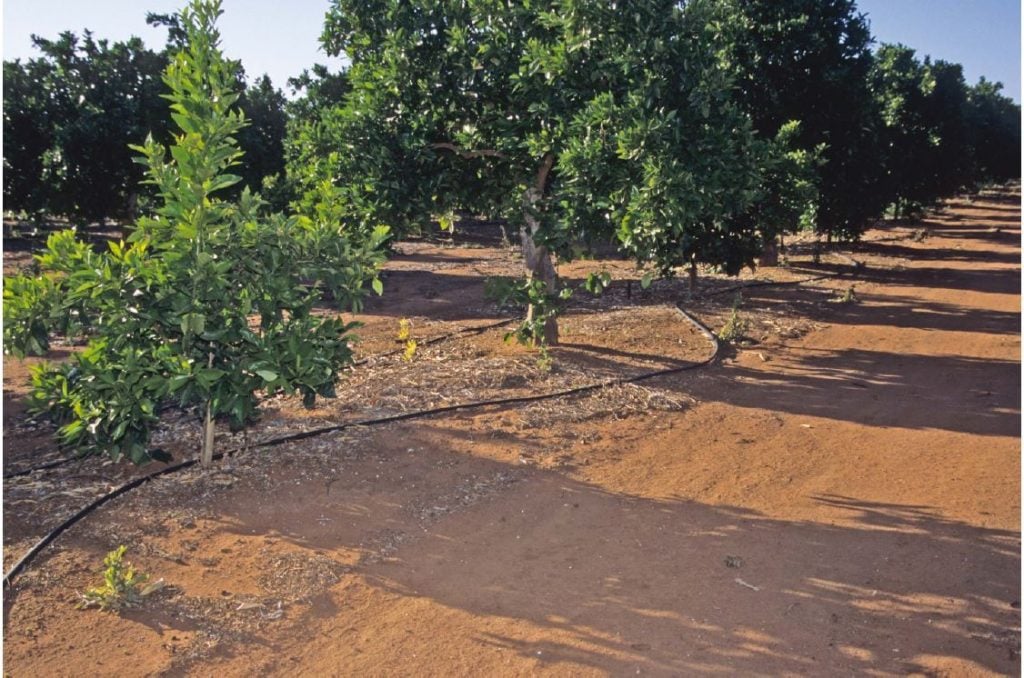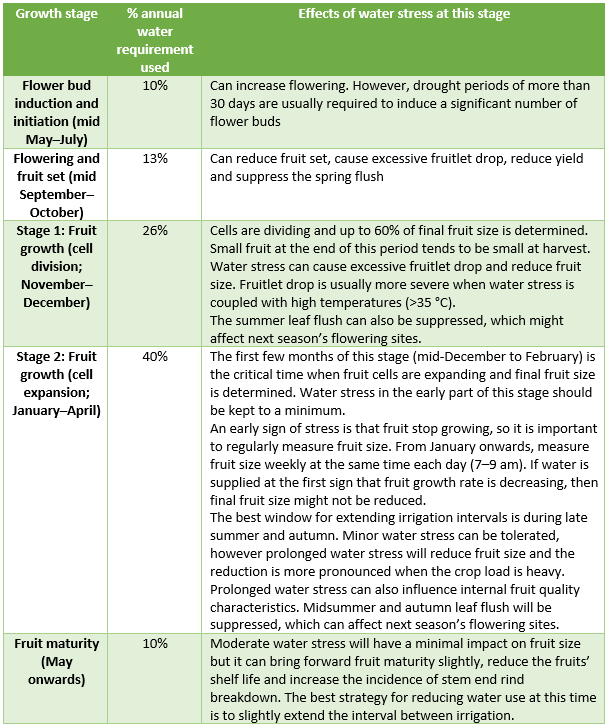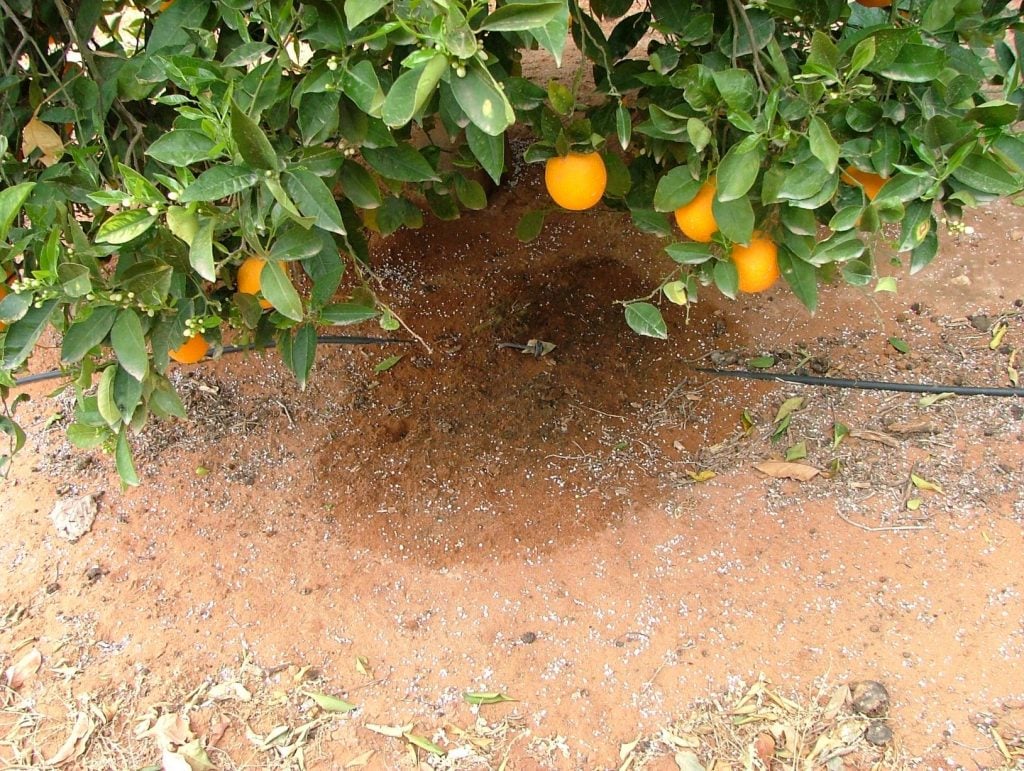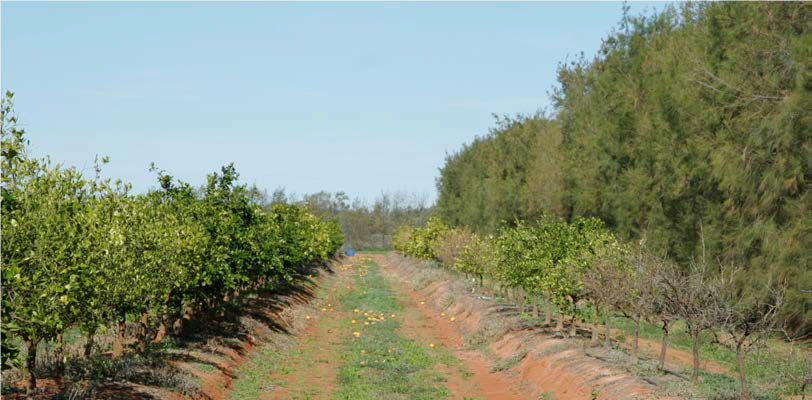How to manage citrus orchards with less water

The content of this article was published by Extension Aus.
To manage citrus orchards with less water requires an understanding of your orchard’s water requirements and the impacts of water stress. There are a variety of options to consider when managing an orchard with reduced water availability.
When considering these options, careful planning, including the use of a water budget should be used to guide decision making. Every farm will be different in the selection and degree of water saving options.
Water and citrus growth
Mature sprinkler-irrigated citrus trees grown in Sunraysia and the Riverland require approximately 1,000–1,200 mm (10–12 ML/ha) of water annually. Yields will decline when less water is applied.
For unrestricted growth, citrus trees require water all year round. The peak demand for water is during the warmer months i.e. October to March, when 74% of the annual allocation is required. Water use declines during late autumn and winter with the onset of cooler temperatures and slower tree growth.
Water stress can affect citrus production at all development stages and stress can occur before any visual symptoms appear. Water availability will influence flowering, fruit set, fruit drop, fruit size, yield, internal fruit quality characteristics and canopy development.
Water stress can also restrict vegetative growth and reduce canopy development, which is especially important in young trees and for next season’s flowering sites. Therefore, the options available for stressing citrus at particular growth stages to save water while remaining productive are limited.
Water saving practices
Immediate strategies
Water Budgeting. Estimating the monthly water requirements for each block using average industry data and your own historical irrigation records can be used to prioritise the allocation of water to blocks.
Install irrigation scheduling devices. It is critical to use soil moisture monitoring devices to accurately check soil water levels and allow irrigation to be scheduled more precisely.
What to know about soil moisture monitoring
Check, manage and maintain the irrigation system. Irrigation systems should be checked for any leaks or blockages. If irrigation uniformity is poor, contact an irrigation consultant for advice on how improvements can be made. The effect an inefficient system has on an orchard will be exacerbated during times of drought.
Maintaining a drip irrigation system
Avoid leaching losses. Ensure water is not applied and lost below the root zone by monitoring soil moisture levels and irrigation depth.
Mulch the wetted strip. Applying mulch over drip irrigation lines helps reduce soil evaporation. It can be a useful option for young trees where a large percentage of the soil surface is exposed.
Reduce the wetted area. This is most applicable to young plantings. If irrigating with low level sprinklers, creating a narrower throw eliminates water application to the inter-row area where roots have not yet significantly colonised. Run times can be shortened while still ensuring the majority of the root zone is watered.
For drip irrigated orchards, plugs can be installed between trees leaving only the emitters near the tree functioning.
Full cover weed control. Removing weeds and eliminating sods will reduce competition for water.
Irrigate at night. Under-tree sprinkler irrigating at night can provide water savings of 20-30% compared with daytime irrigation by reducing evaporation losses.
Eliminate water run-off. If surface run-off is occurring, consider improving water penetration and soil aeration such as applying gypsum.
Reduce or cease windbreak irrigation. This can save water, but jeopardise the long-term benefits of windbreaks.
Re-use back flush water. Ensure excessive back-flush volumes are not being generated. Can be re-used if run to a settling tank.
Reduce crop load. Reducing or eliminating the crop load can help to reduce water stress effects on fruit size. Trees carrying heavy crop loads will suffer more stress than trees with a lighter crop.
Buy or trade water. Buying or leasing water can be a viable option. Consider the long-term value of the trees and crops compared with the cost of water.
Longer-term strategies
Install valves for each patch. Separate valves to blocks or patches that have different water requirements allows a more accurate match of crop water needs with irrigation applications. Water use differs between varieties and tree age. If adopting canopy reduction on part of a block, the irrigation system should be modified to cater for the significant differences in water requirements which are created.
Convert to efficient irrigation systems. Drip irrigation is potentially the most efficient irrigation system with possible savings of 40–60% over furrow and overhead sprinkler systems and up to 30% on under-tree sprinkler systems.
A new drip irrigation system requires substantial investment and should be professionally designed. If there is a high probability that water restrictions will continue in the future, serious consideration of the long-term financial viability should be given to installing drip irrigation.
















































